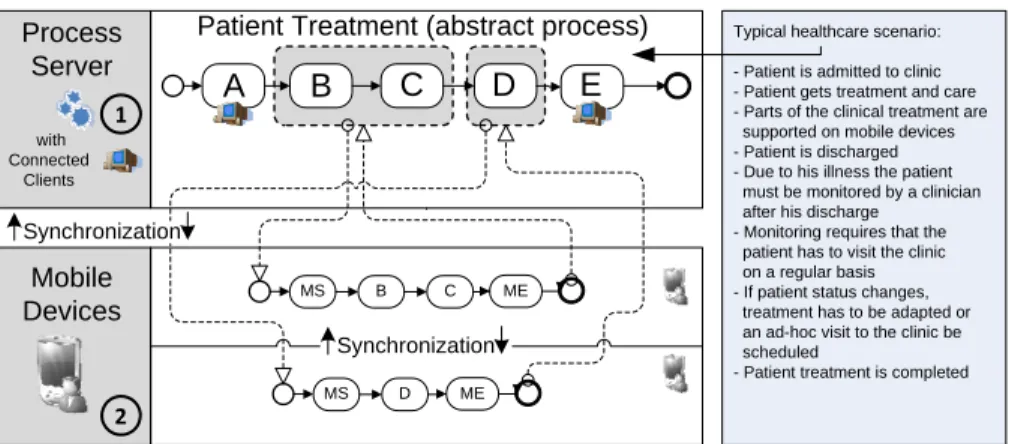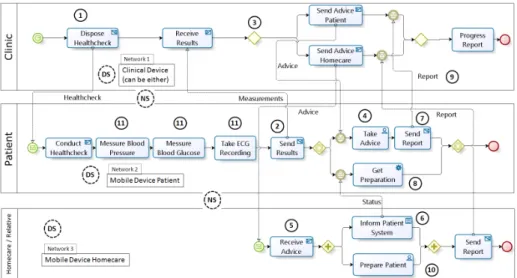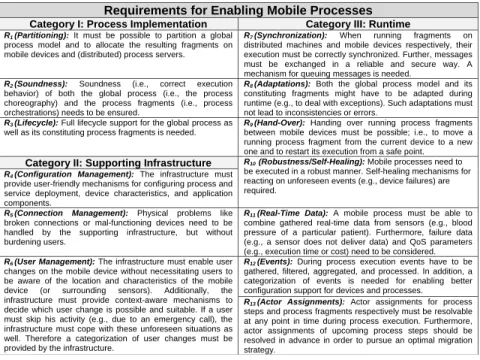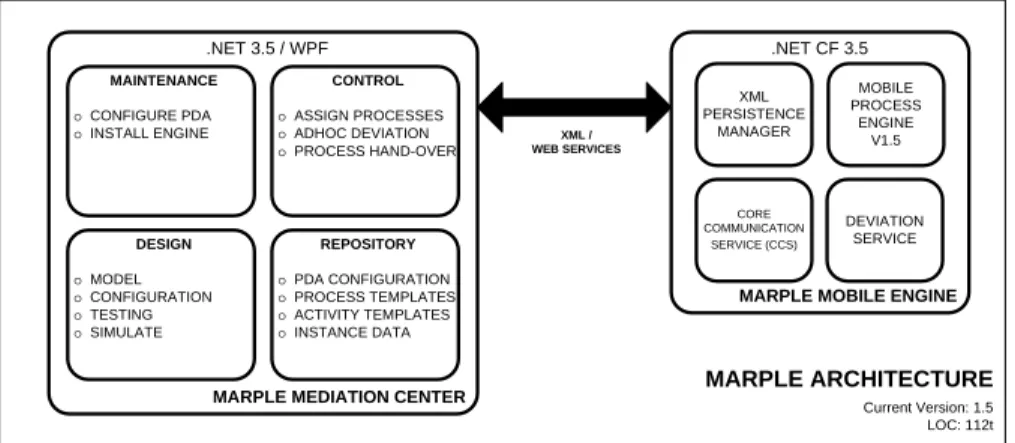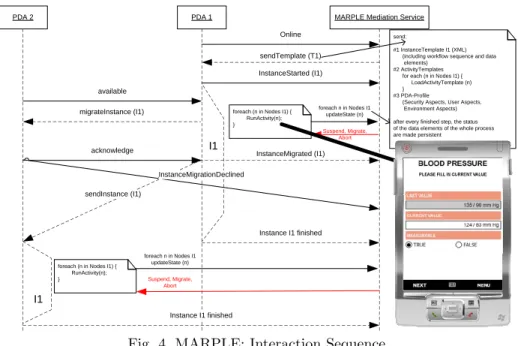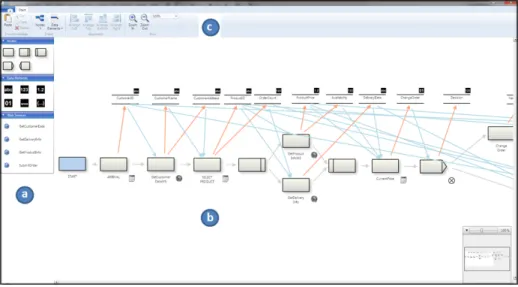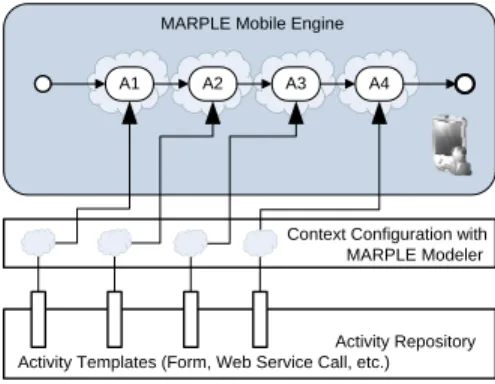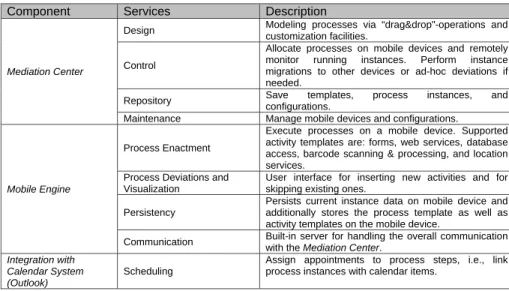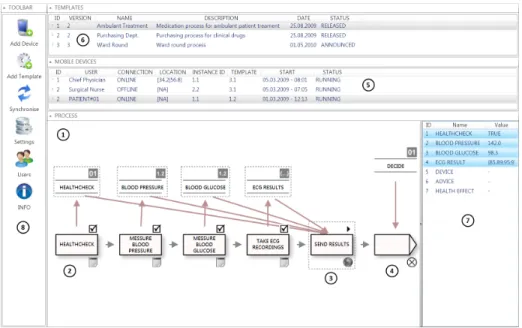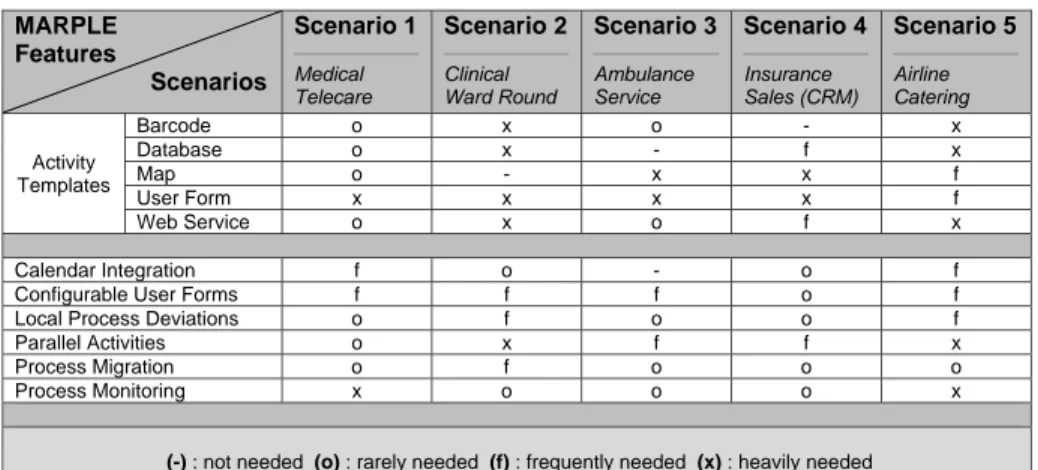on Mobile Devices
R¨udiger Pryss, Julian Tiedeken, Ulrich Kreher and Manfred Reichert
Institute for Databases and Information Systems, Ulm University, Germany {ruediger.pryss, julian.tiedeken, ulrich.kreher, manfred.reichert}@uni-ulm.de
Abstract. Ubiquitous computing is considered as enabler for linking everyday life with information and communication technology. However, developing pervasive and mobile applications that provide personalized user assistance still constitutes a challenge. Mobile application scenar- ios are diverse and encompass domains like healthcare, logistics, and sales. For their support two fundamental technologies with increasing maturity are emerging:development frameworks for mobile devices and light-weight process engines. Their integrated use, however, is in a rather premature state. Generally, the use of a process engine for supporting mobile collaboration raises many challenging issues. This paper picks up some of these challenges and shows how we have coped with them in the MARPLE project. MARPLE targets at a tight integration of pro- cess management technology with mobile computing frameworks in or- der to enable mobile process support in advanced application scenarios.
We give insights into the MARPLE architecture and its components.
In particular, we introduce the MARPLE process engine, which enables light-weight as well as flexible process support on mobile devices. This will be key for mobile user assistance in advanced application scenarios.
Key words: Mobile Process, Distributed Process, Process Management
1 Introduction
Mobile assistance in daily life as empowered by information and communication technology is a much discussed topic [1, 2]. To better understand relating chal- lenges, we analyzed real-world process scenarios from different domains in which mobile user assistance is urgently needed. This includes process scenarios from healthcare, logistics, and sales. Altogether, our studies revealed the fundamental role of process support in the context of mobile and personalized user assistance.
In this paper we pick up a realistic healthcare scenario in which chronically ill patients shall be assisted by mobile devices. The latter shall give recommenda- tions about therapies (e.g., medications), collect data from the patient, or help general practioners to plan encounters with their patients. Recommendations may be made remotely by healthcare professionals and often depend on previ- ously gathered patient data (e.g., blood pressure or blood sugar). Despite its high potential, so far, there exists no comprehensive mobile user assistance for realizing such scenarios in a flexible way and in a large scale. One major task in
this context is to decide which parts of a global process (i.e.process fragments) shall run on mobile devices (e.g., a patient’s mobile) and which ones shall be controlled by process servers (e.g., running on the physician’s workstation or any other backend server). In the following we refer to such a healthcare scenario to discuss fundamental challenges, and to show the benefits coming with mobile user assistance. Fig. 1 illustrates both a traditional realization of this scenario () and its implementation based on mobile user assistance (1 +1 ).2
Typical healthcare scenario:
- Patient is admitted to clinic - Patient gets treatment and care - Parts of the clinical treatment are
supported on mobile devices - Patient is discharged - Due to his illness the patient
must be monitored by a clinician after his discharge
- Monitoring requires that the patient has to visit the clinic on a regular basis - If patient status changes,
treatment has to be adapted or an ad-hoc visit to the clinic be scheduled
- Patient treatment is completed ME
Patient Treatment (abstract process) Process
Server
Mobile Devices
1 1
21
A B C D
B C
MS with
Connected Clients
E
ME D MS
Synchronization Synchronization
Fig. 1. Abstract Healthcare Scenario (see Fig. 2 for a connect scenario) After discharging patients the usual way to monitor their health status is to schedule regular visits for them in the clinic. In certain cases, however, this can lead to delayed adaptations of treatment plans, e.g., if patient status changes while they stay at home. To improve this situation and to enable remote moni- toring of patients (cf. Fig. 1 Steps B,C), mobile data collection and mobile user assistance 2 would be highly welcome by all parties; i.e., patients should be assisted by a mobile device which gathers medical data from them and informs clinicians about important status changes. Further, it should enable clinicians to remotely adapt their treatment plan or to schedule meetings with patients if required. In addition, it might be desirable to run parts of the treatment pro- cedure on mobile devices (cf. Fig. 1 Step D). To realize such scenario and to provide personalized treatment support, patient-specific application logic needs to be provided on the mobile device. As a consequence, the overall treatment process is partitioned 2 and the resulting process fragments are deployed to both process servers and mobile devices. In particular, process fragments run- ning on mobile devices need to be quickly configurable to the specific patient and be dynamically adapted if patient’s status changes. Hard-coded process imple- mentations are therefore not adequate in this context. Instead flexible support of processes with mobile assistance is needed.
To enable mobile process assistance we developed a light-weight process engine calledMARPLE1 that runs on mobile devices and is able to interact with back- end processes if required. In addition, we provide advanced tools for defining,
1 MAnagingRobust mobileProcesses in a compLEx world
configuring, verifying and deploying process fragments in such an environment.
In the following, we focus on fundamental challenges on the one hand and on the core architecture and components of theMARPLE mobile process engine on the other hand. Conceptual issues related to the partitioning of processes as well as to the synchronization of the resulting process fragments are outside the scope of this paper. When developing theMARPLE engine we had one shining example in mind - the ADEPT process management system, which we had developed during the last decade [3]. In particular, we adopted basic design principles from ADEPT (e.g., its correctness-by-construction principle and its dynamic process change capabilities), but also aligned the MARPLE architecture with specific needs relating to mobile process support.
The remainder of this paper is organized as follows: Section 2 introduces a con- crete application scenario. In Section 3 we describe requirements derived from case studies as basis for theMARPLE architecture. Section 4 gives insights into the MARPLE architecture, while Section 5 shows how the described application scenario can be supported. In Section 6 we discuss selectedMARPLEfeatures in the context of advanced application scenarios. Section 7 discusses related work and Section 8 concludes with a summary and outlook.
2 Application Scenario
Fig. 2 shows a typical healthcare process (modeled in terms of BPMN) involving three parties: clinic, patient, and homecare. The first swim lane shows activities as performed in the clinic, which also starts the process. When completing Step , the execution of the process fragment on the mobile device of the patient is1
triggered (patient swimlane). This mobile process then collects medical data from the patient and coordinates required actions; e.g., to measure blood pressure or to gather ECG data.
Fig. 2. Healthcare Process with Mobile Patient Assistance
Let us consider the patient-specific process fragment in more detail: While the patient stays at home, he gets a message from the clinic through his mobile device. Then he measures and collects the requested data being assisted by the process fragment running on his mobile device. Following this, results are sent back to the clinic, which then decides about next steps2 . Ideally, everything3
is OK and no special actions concerning the patient are required. In this case a message is sent back to the mobile device containing information about the patient’s medication . In case of problems, the clinic might send an alterna-4
tive message with information about further or special treatment to homecare5
(either provided by a professional service or by relatives of the patient). In the latter case, an additional process fragment is started on the mobile device of the person being responsible for homecare. Its execution then has to be synchronized with the one running on the patient’s mobile device. Finally, either the process running on the mobile device of homecare or the one of the patient sends back a report7 to the clinic, before the process is finished.
3 Requirements
Table 1 gives an overview of characteristic requirements raised when running processes and process fragments on mobile devices. We elicitated these require- ments when analyzing different process scenarios from domains like healthcare, sales, logistics, and emergency management.
Requirements for Enabling Mobile Processes Category I: Process Implementation Category III: Runtime R1 (Partitioning): It must be possible to partition a global
process model and to allocate the resulting fragments on mobile devices and (distributed) process servers.
R7 (Synchronization): When running fragments on distributed machines and mobile devices respectively, their execution must be correctly synchronized. Further, messages must be exchanged in a reliable and secure way. A mechanism for queuing messages is needed.
R2 (Soundness): Soundness (i.e., correct execution behavior) of both the global process (i.e., the process choreography) and the process fragments (i.e., process orchestrations) needs to be ensured.
R8 (Adaptations): Both the global process model and its constituting fragments might have to be adapted during runtime (e.g., to deal with exceptions). Such adaptations must not lead to inconsistencies or errors.
R3 (Lifecycle): Full lifecycle support for the global process as well as its constituting process fragments is needed.
R9 (Hand-Over): Handing over running process fragments between mobile devices must be possible; i.e., to move a running process fragment from the current device to a new one and to restart its execution from a safe point.
Category II: Supporting Infrastructure R10 (Robustness/Self-Healing): Mobile processes need to be executed in a robust manner. Self-healing mechanisms for reacting on unforeseen events (e.g., device failures) are required.
R4 (Configuration Management): The infrastructure must provide user-friendly mechanisms for configuring process and service deployment, device characteristics, and application components.
R5 (Connection Management): Physical problems like broken connections or mal-functioning devices need to be handled by the supporting infrastructure, but without burdening users.
R11 (Real-Time Data): A mobile process must be able to combine gathered real-time data from sensors (e.g., blood pressure of a particular patient). Furthermore, failure data (e.g., a sensor does not deliver data) and QoS parameters (e.g., execution time or cost) need to be considered.
R6 (User Management): The infrastructure must enable user changes on the mobile device without necessitating users to be aware of the location and characteristics of the mobile device (or surrounding sensors). Additionally, the infrastructure must provide context-aware mechanisms to decide which user change is possible and suitable. If a user must skip his activity (e.g., due to an emergency call), the infrastructure must cope with these unforeseen situations as well. Therefore a categorization of user changes must be provided by the infrastructure.
R12 (Events): During process execution events have to be gathered, filtered, aggregated, and processed. In addition, a categorization of events is needed for enabling better configuration support for devices and processes.
R13 (Actor Assignments): Actor assignments for process steps and process fragments respectively must be resolvable at any point in time during process execution. Furthermore, actor assignments of upcoming process steps should be resolved in advance in order to pursue an optimal migration strategy.
Table 1. Requirements Overview
Reconsider our example from Section 2. In this simple scenario three process fragments exist whose execution needs to be synchronized among the three par- ties. In this context, the overall system architecture must be able to cope with communication problems, device failures, and so forth. In Fig. 2 the pictograms with label DS and NS indicate potential network and device switches within the overall process choreography. For example, assume that the mobile device of the patient or its connection with the clinic fail. Consequently, the clinic has no information about the status of the patient, but only knows that the network connection is broken. Such failure scenarios must be adequately covered by the architecture.
4 MARPLE - Overview and Architecture
We first describe theMARPLE architecture (cf. Fig. 3) whose two core compo- nents are theMARPLE Mobile Engineand theMARPLE Mediation Center. We focus on those parts of the MARPLE architecture that are fully implemented and relevant in the context of our application scenario. Other components of MARPLE are only sketched and will be subject of future papers.
MARPLE ARCHITECTURE
MARPLE MEDIATION CENTER MAINTENANCE
oCONFIGURE PDA oINSTALL ENGINE
CONTROL oASSIGN PROCESSES oADHOC DEVIATION oPROCESS HAND-OVER
DESIGN oMODEL oCONFIGURATION oTESTING oSIMULATE
REPOSITORY oPDA CONFIGURATION oPROCESS TEMPLATES oACTIVITY TEMPLATES oINSTANCE DATA
MARPLE MOBILE ENGINE
XML / WEB SERVICES
.NET 3.5 / WPF
XML PERSISTENCE
MANAGER
MOBILE PROCESS
ENGINE V1.5
CORE COMMUNICATION
SERVICE (CCS)
.NET CF 3.5
DEVIATION SERVICE
Current Version: 1.5 LOC: 112t
Fig. 3. MARPLE Architecture
4.1 MARPLE Mediation Center
TheMARPLE Mediation Center (cf. Fig. 3) consists of four major parts. First, its Maintenance component enables configuration of mobile devices such that they can be used for mobile process support. Second, theControl Unit enables users to assign executable process fragments to mobile devices, to enact them on the mobile device, to invoke user forms, web services and other kinds of activity components during process fragment execution, and to define ad-hoc deviations from the prescribed process logic if required. Another fundamental feature of the MARPLEControl Unit is its ability to hand-over running process fragment instances from one mobile device to another; e.g., if a patient wants to switch his
device or a homecare person wants to hand over his process fragment to someone else. Like in the case of ad-hoc changes, such hand-over can be initiated locally by the owner of the mobile device as well as remotely by authorized users via theControl Unit.
Fig. 4 exemplarily illustrates possible interactions between theMARPLE Media- tion Service and two mobile devices. Initially, only one mobile device is involved in the interaction. Then a second device is added. Following this, the process in- stance running on the first mobile device is handed over to the newly introduced one, e.g., due to connection problems with the first device, better technical fea- tures of the new one, or needed hand-over of tasks. As mentioned this handing over can be triggered either by theMARPLE Mediation Center or by the device owners. During process execution, theControl Unitmay suspend, resume, abort, and monitor running processes. Finally, MARPLE Mobile Process Engine V1.5 logs process events using thePersistence Manager (cf. Fig. 3).
PDA 2 PDA 1 MARPLE Mediation Service
Online
InstanceStarted (I1) sendTemplate (T1)
foreach (n in Nodes I1) { RunActivity(n);
} available
migrateInstance (I1)
acknowledge I1
Instance I1 finished InstanceMigrated (I1)
foreach n in Nodes I1 updateState (n)
sendInstance (I1)
InstanceMigrationDeclined
Suspend, Migrate, Abort
foreach (n in Nodes I1) { RunActivity(n);
}
I1
foreach n in Nodes I1 updateState (n)
Suspend, Migrate, Abort
Instance I1 finished
send:
#1 InstanceTemplate I1 (XML) (including workflow sequence and data
elements)
#2 ActivityTemplates for each (n in Nodes I1) {
LoadActivityTemplate (n) }
#3 PDA-Profile
(Security Aspects, User Aspects, Environment Aspects) after every finished step, the status of the data elements of the whole process are made persistent
Fig. 4. MARPLE: Interaction Sequence
Another important aspect that emerges when integrating end-users and process management technology on mobile devices concerns usability. We provide ad- vanced support for deploying the MARPLE process engine to mobile devices.
TheMediation Center makes the engine available through web services, which enables users to deploy it to their mobile devices.
4.2 MARPLE Modeler
Another important component of the MARPLE Mediation Center is its Mod- eler, which adopts the basic correctness principles and verification procedures we developed in ADEPT [4]. Additionally, it provides features for partition- ing global processes into several process fragments, for allocating the resulting
process fragments to different machines (e.g., mobiles devices), and for linking process activities with activity components (cf. Sect. 4.4). Consider again our example from Section 2. UsingMARPLE Modeler, for instance, the process frag- ment, coordinating data collection steps and running on the mobile device of the patient, can be defined (see Fig. 5). TheMARPLE Modeler is subdivided into three areas: The toolbar on the left sidea depicts available modeling elements:
Activity Nodesand Connectors, Data Elements, andActivity Templates.
b depicts the main area of the Modeler: Basically, the process model can be created through drag & drop operations, which copy elements from the toolbar to the design area. Finally, the top toolbarc provides useful modeling functions (e.g. for layouting the models). TheMARPLE Modeler is based on theWindows Presentation Foundation as part of the Microsoft .NET Framework. The pro- cess elements depicted within areab are defined using XML. The editor stores modeled process fragments via XSLT-transformation according to the internal format required by theMARPLE Repository.
Fig. 5. MARPLE Modeler
Configurable user forms:User-friendliness is one major aspect for mobile ap- plications. As we learned in our healthcare case studies, physicians and nurses rapidly become discouraged when being confronted with inappropriate user in- terfaces. We therefore integrated a form editor with the MARPLE Modeler. It comprises features to cope with the problem of limited screen size on mobile devices (e.g., if too many data elements shall be displayed in one form, this can be splitted into two forms). In addition, to meet context demands (like in emergency situations), we added specific features for enabling more sophisticated user interactions. For example, instead of entering data manually, a physician or nurse may enter it only through pre-defined controls.
4.3 MARPLE Mobile Engine
When developing the MARPLE Mobile Process Engine, we re-used basic con- cepts and design principles of the ADEPT process management technology, which we had developed during the last decade [3]. In particular, we adopted the ADEPT process meta model, applied its fundamental correctness notions as well as verification procedures, and support flexible and adaptive process en- actment on the mobile device as well. The latter enables dynamic structural adaptations of process fragment instances running on the mobile device; e.g., to cope with contextual changes in the environment or exceptional situations. Basic to the support of such ad-hoc changes is theMARPLE Mobile Deviation Ser- vice. Despite these commonalities with ADEPT it is noteworthy that we provide a complete new implementation of the kernel of the MARPLE Mobile Process Engine in order to meet performance requirements of mobile scenarios and to cope with issues specific to mobile processes (e.g., broken connections and lim- ited GUIs). In particular, the implementation framework on which MARPLE is based differs from the one used in ADEPT - ADEPT relies on JAVA, while MARPLE is based on.NET Compact Framework. In the following we describe selected services of theMARPLE Mobile Process Engine in more detail.
Configuring mobile devices:When a mobile device is added to theMARPLE environment, it first needs to be equipped with basic software services. Amongst others, this includesCore Communication Services (CCS) as basic pillar of the MARPLE Mobile Process Engine V1.5. Thereby, we apply a light-weight ap- proach; i.e., services initially not needed are not uploaded to the device. Fol- lowing this, the mobile device can connect to theMARPLE Mediation Center.
When starting theMARPLEconfiguration procedure on the mobile device using theMARPLE Mediation Center, CCS dynamically loads theMARPLE Mobile Process Engine, theXML Persistence Manager, and selected process as well as activity templates (see also Section 4.4) to this device. The XML Persistence Manager fulfills two functions: First, it allows (de)serializing process models in order to exchange them between the MARPLE Mediation Center and the mo- bile devices. Second, it enables the storage of process models on mobile devices.
Fig. 6. Parallel Execution Enactment of processes on mobile
devices:MARPLE allows to deploy pro- cess models and fragments, respectively, to mobile devices and to create corre- sponding instances. In the first version of the MARPLE Mobile Process Engine we only considered the execution patternsse-
quenceandconditional routing. Later we added support for theparallel execution of process activities on mobile devices, which is required for performing “back- ground” activities, e.g., database operations or web service calls (cf. Fig. 6).
Parallel processing of activities on mobile devices can be also utilized to reduce throughput times and error probabilities as well as to enable better monitor-
ing. Due to limited screen size of mobile devices, however, concurrent execu- tion of activities on mobile devices should be more restrictive than on normal process servers. Displaying multi-windows simultaneously, for example, is not meaningful. For process fragments running on mobile devices,MARPLE there- fore disallows the concurrent processing of forms referring to different parallel branches. As example consider Step 6 of our healthcare scenario from Section 2. Here messages are sent to the patient device in parallel to the form-based process step Prepare Patient (as performed by homecare). Parallel processing is very helpful in the given context to foster monitoring. Let us consider that the process instance of the patient shall be monitored by a clinical doctor and homecare is involved. The homecare process fragment sends (cf. Fig. 2) in paral- lel information back to the activityPrepare Patient. This enables the clinician to already monitor the activity Prepare Patient during execution without waiting of its finishing. Especially, if the activity has a long duration, this information could be very important.
Fig. 7. Ad-hoc De- viations
Ad-hoc deviations during mobile process enact- ment: The ability to deviate from pre-modeled process templates during runtime is crucial for mobile process sup- port. Both changes in the local environment (e.g., blood pressure of a patient increases) and changes in the infras- tructure or global environment (e.g., a particular sensor is not measuring data) might require ad-hoc changes of a mo- bile process. For example, if results are missing during the examination of a patient, but are urgently needed, medical tests or procedures may have to be dynamically added. To be able to adjust a particular instance of the mobile pro- cess correctly and quickly during runtime, we implemented a sub-component of theMARPLE Mobile Process Engine that enables users to locally adapt processes running on the mobile device. Thereby,MARPLEdisplays the process to the user and offers a number of context-enabled changes (cf. Fig. 7). The of- fered set is based on context information provided locally through theMARPLE Mobile Process Engine (e.g., regarding the current status of the executed frag- ment and the role of the respective user). Change operations implemented so far include the insertion and deletion of single activities. In the current imple- mentation only human tasks (i.e., form-based activities) can be added or deleted locally. In our future research, remote adaptation of process fragments running on mobile devices will become a topic of interest as well.
Integration with calendar systems:On the one hand many companies use collaboration tools like e-mail clients and calendar systems with built-in sched- ule capabilities. On the other hand, mobile scenarios like the one from Section 2 are usually linked with many related time events, of which some can be related to calendar items. Regarding our healthcare scenario, one important time event
at the clinic concerns the triggering of the whole process. Assume that doctors have to trigger such events manually. Then it would be highly welcomed by them if the activity had been linked to their personal calendar. Amongst others this would reduce omission errors. Furthermore, if the activity has to be post- poned, the infrastructure can explicitly cope with this situation. We therefore interlinked theMARPLE Architecture withMicrosoft Outlook. With the help of the MARPLE Mediation Center the interaction between the two tools can be configured. The MARPLE Mobile Process Engine then starts process instances on the mobile device accordingly to pre-defined calendar items.
4.4 Activity templates
In MARPLE, single process steps can be implemented based on reusable Ac- tivity Templates (cf. Fig. 8). These encapsulate pre-manufactured application components.
A1 A2 A3 A4
MARPLE Mobile Engine
Activity Repository MARPLE Modeler Context Configuration with
Activity Templates (Form, Web Service Call, etc.)
Fig. 8. Activity Templates
Their implementation must be adllcomponent of the.NET Com- pact Framework. We store available activity templates in theMARPLE Repository. Based on the latterac- tivity templates are linked to pro- cess steps at design time using the MARPLE Modeler. Thereby, they have to be configured to the given context.Activity Templatesfurther must be provided with a number of configure parameters depending on the given type (e.g., concrete pa- rameters for a web service call like the message format or URI). Dur- ing process execution, the MARPLE Mobile Process Engine loads the activity templates incrementally when activating process steps (cf. Fig. 8).
As standard activity templates MARPLE provides support for invoking user forms and web services as well as for evaluating transition (xor) conditions.
Based on respective core activity templates, simple mobile scenarios like the one from Section 2 can be implemented. As example consider activity11 in our sce- nario, where the user interacts with a form to enter his blood pressure value.
From other mobile process scenarios we implemented with MARPLE, we re- vealed the need for additional kinds of activity templates covering locations awareness, database connectivity, and barcode management.
Database activity template: When investigating mobile scenarios from the sales domain we started considering database functions for mobile process man- agement. We talked to sales representatives from the insurance domain and
collected characteristic requirements. Most prominently, they claimed that data management in respect to their mobile device and applications is not satisfac- tory. An appropriate data management component needs to cover three aspects.
First, required customer data should be automatically transferred to the mobile device in advance (e.g., by utilizing information about customer appointments).
Second, for a process running on the mobile device and its interlinked processes in the backend, data consistency must be ensured. Third, if no connection can be made during the meeting with a customer, correct re-transfer of data into the backend system should be provided. All these steps require a database con- nection in order to perform respective queries. To meet this requirement, we implemented a database activity template. Since parallel processing of activities on the mobile device is possible inMARPLE any activity based on the database template can frontload data for later process activities. For example, while the sales manager runs form-based activities for entering customer data, certain data management steps can be executed in parallel. Additionally, data collected via the mobile device can be transferred back to the backend system at the earliest point in time. Consequently, this data can be used for recovery purposes, e.g., when an abnormal situation (e.g., broken device) occurs.
Fig. 9. Barcode Reading
Activity templates enabling sensor awareness:
One major goal of MARPLE is to provide personalized and situation-aware mobile processes. For reaching this objective the integration of real-time data as provided by sensors (e.g., blood pressure of a particular patient can be gathered via Bluetooth) with mobile processes is needed. Our healthcare scenarios indicated that often patient data can be gathered via sensors (e.g., measur- ing pulse, respiration, blood pressure, and body temper- ature). The gathered data then has to be processed, aggregated, and interpreted considering the given context. Due to lack of process-awareness, effective process- ing of this data is usually limited. We further learned from our clinical scenarios that sensor-gathered data is usually only visualized based on specialized applica- tions provided by the sensor vendor. In order to utilize such context data (e.g., a medical parameter has exceeded its threshold multiple times) we are developing Activity Templates that enable sensor-awareness. We have already implemented a Barcode Activity Template, which enables users to scan data collectable from packages (e.g., drug packages) (cf. Fig. 9). As example consider the clinical ad- mission of patients. The barcode of medications brought along by the patients to the clinic could be scanned and archived in the patient record. In the context of another project in the field of airline catering, we are currently working on a RFID Activity Template. This template shall enable users to read RFID tags and utilize gathered data within the mobile processes respectively.
Fig. 10. Street Map Integra- tion
Map Activity Template:Mobility implies a larger extent of flexibility on the one hand, and a lot more sources of problems (e.g. no network connection, limited battery life) on the other hand. This must be considered in the context of mobile process execution as well. Location awareness is one feature we should add when compared to classical workflows.MARPLE therefore supports a location activity template, which can display either the current user location, if a GPS module exists, or any location based on given coordinates (cf. Fig. 10). Regarding our sample process this activity template can be used to realize Step5 in order to guide the homecare service when visiting the patient.
Furthermore, context information about location can be used to provide context-specific assistance for users (e.g., by only
displaying those instances to them which are relevant in the given context).
Additionally, coordinates of the mobile devices can be periodically submitted to the Mediation Center. This way resources (e.g. workload, errands) can be managed in a more efficient way.
4.5 Summary of the MARPLE Features
Table 2 summarizes core features of MARPLE components:
Component Services Description
Mediation Center
Design Modeling processes via “drag&drop"-operations and customization facilities.
Control
Allocate processes on mobile devices and remotely monitor running instances. Perform instance migrations to other devices or ad-hoc deviations if needed.
Repository Save templates, process instances, and
configurations.
Maintenance Manage mobile devices and configurations.
Mobile Engine
Process Enactment
Execute processes on a mobile device. Supported activity templates are: forms, web services, database access, barcode scanning & processing, and location services.
Process Deviations and Visualization
User interface for inserting new activities and for skipping existing ones.
Persistency
Persists current instance data on mobile device and additionally stores the process template as well as activity templates on the mobile device.
Communication Built-in server for handling the overall communication with the Mediation Center.
Integration with Calendar System (Outlook)
Scheduling
Assign appointments to process steps, i.e., link process instances with calendar items.
Table 2. Marple Architecture Feature Overview
5 Realizing the Healthcare Scenario with MARPLE
We revisit our scenario from Section 2 and show how it can be realized using MARPLE. Fig. 11 depicts the user interface of theMARPLE Mediation Center
and shows a concrete process instance running on a mobile device as it can be monitored with theMARPLE Mediation Center. Note that this perspective dis- plays both the current status of the mobile process and the data values collected during process execution (see ). Obviously, this is exactly the information a7
medical professional needs when remotely monitoring the patient process.
How does the patient process fragment look like in MARPLE: Fig. 11 depicts a part of this model together with instance-specific markings. Activity 2 con- stitutes a receive activity which is waiting for an incoming message requesting a health check. The following three activities constitute data collection steps, which are either implemented as user forms or sensing activities. The blood pressure, in turn, is gathered via a bluetooth activity template which is linked with the blood pressure measurement machine. Blood glucose and ECG record- ings are entered by users via form-based activities; i.e., the user of the mobile device gets respective requests in his worklist and then has to fill in the two forms (e.g. see the PDA display in Fig. 4).
Following data collection, activity3 is automatically executed. It invokes a web service at the clinic to report about measured results (e.g., to add them to the electronic patient record). The subsequent activity4 then waits until a message is received either from the clinic or from homecare. The administrator toolbar on the left side of Fig. 118 displays available functions for managing process tem- plates, users, mobile devices, and mobile device settings. Further,6 displays the list of currently released process templates, which can be assigned to registered mobile devices.
Fig. 11. MARPLE: Mediation Center
6 Evaluation of Mobile Process Support with MARPLE
We applied MARPLE to process scenarios from healthcare, logistics and sales, which we implemented using the MARPLE Architecture. We learned that the provision of a light-weight process engine for mobile devices is essential in order to realize human-centric processes. Furthermore, our prototypical implementa- tions revealed additional demands we picked up in this paper. Table 3 gives an overview of the considered scenarios and relates them toMARPLE features.
MARPLE Features
Scenarios
Scenario 1
Medical Telecare
Scenario 2
Clinical Ward Round
Scenario 3
Ambulance Service
Scenario 4
Insurance Sales (CRM)
Scenario 5
Airline Catering
Activity Templates
Barcode o x o - x Database o x - f x
Map o - x x f
User Form x x x x f Web Service o x o f x Calendar Integration f o - o f
Configurable User Forms f f f o f
Local Process Deviations o f o o f Parallel Activities o x f f x
Process Migration o f o o o Process Monitoring x o o o x
(-) : not needed (o) : rarely needed (f) : frequently needed (x) : heavily needed
Table 3. Marple Features Usage
7 Related Work
In literature, we can find several approaches which focus on logical models for mobile processes on the one hand and approaches addressing architectural and implementation issues of light-weight process engines on the other hand. Regard- ing the first category, for example, several approaches exist for the partitioning of BPEL processes [5, 6, 7, 8]. A similar approach has been suggested in the context ofADEP Tdistribution[9, 10]. However, none of the two approaches has provided an architecture for mobile process support as MARPLE does. Taking network dynamics as core demand for mobile process engines, several approaches deal with failures and exceptions like broken connections or lack of communication facilities [11, 12, 13, 14]. Respective tools usually apply web service standards and base process execution on BPEL or more specific execution models derived from it. We consider the use of BPEL as process execution language as too low level, particularly if it shall be possible to dynamically evolve or adapt mobile processes during runtime. Instead we provide a process model at a higher level of abstrac- tion that can be adapted by both remote users and users of the mobile device.
We further believe that self-healing techniques and migration management will be crucial for mobile processes in the large scale. However, existing approaches dealing with these aspects in process-aware information systems, again focus on
BPEL as execution language [6, 15]. The same applies in respect to mobile pro- cesses [16]. As described, combining real-time data and domain knowledge raises additional challenges for mobile process management. The MobiHealth project [17], for example, supports context-aware services which allow to integrate sen- sor data. However, context-awareness is restricted in the sense that execution can only be switched between pre-configured process variants when the context is changing. Generally, approaches allowing to switch between pre-configured process variants can be found in other projects as well [18, 16]. However, the fusion of real-time data and domain knowledge with mobile processes has not been considered in a suitable manner yet. Finally, there are approaches focus- ing on process-aware systems using web services and running on mobile devices [19, 7, 20]. They enable simple web service flows on mobile devices based on a mobile engine. Approaches only focusing on web service calls, however, restrict the potential of mobile processes in several respects.
8 Summary and Outlook
We introduced the MARPLE approach and described how its core components enable the execution and monitoring of processes (fragments) on mobile devices.
Our overall vision is to provide sophisticated mobile process support; i.e., to re- alize generic process management features including support for process instance changes, process instance migrations, sensor data integration, etc. To foster this vision we base our presented work on core design principles and fundamental concepts we developed in our ADEPT project as well as ourADEP Tdistribution
project [10, 21]. In future work we will extend theMARPLE Modeler such that it provides sophisticated methods for modeling complex process choreographies including numerous process servers, devices, and actors possibly distributed over many departments. This will include, for example, a methodology for correctly partitioning processes models, for allocating resulting fragments on different ma- chines and devices based on more intelligent allocation techniques, and for syn- chronizing different process fragments at runtime. In particular, we will adopt and extend concepts from autonomic computing and self-healing systems [22] to cope with the many failure scenarios in connection with distributed and mobile applications. This will be crucial when realizing mobile processes in the large scale.
References
1. Smith, H., Fingar, P.: Business Process Management: The Third Wave. Meghan- Kiffer Press (2003)
2. Bonnici, E., Welch, P.H.: Mobile processes, mobile channels and dynamic systems.
In: IEEE Congress on Evolutionary Computation (CEC’09). (2009) 232–239 3. Dadam, P., Reichert, M.: The ADEPT project: a decade of research and de-
velopment for robust and flexible process support - challenges and achievements.
Computer Science - Research and Development23(2009) 81–97
4. Reichert, M., Rinderle-Ma, S., Dadam, P.: Flexibility in process-aware information systems. LNCS Transactions on Petri Nets and other Models of Concurrency (ToPNoC).2(2009) 115–135
5. Baresi, L., Maurino, A., Modafferi, S.: Workflow partitioning in mobile information systems. In: MOBIS’04. (2004) 93–106
6. Baresi, L., Guinea, S.: Dynamo and self-healing BPEL compositions. In: Proc.
29th Int. Conf. on Software Engineering. (2007) 69–70
7. Hahn, K., Schweppe, H.: Exploring transactional service properties for mobile service composition. In: MMS’09. (2009) 39–52
8. Schmidt, H., Hauck, F.J.: SAMPROC: middleware for self-adaptive mobile pro- cesses in heterogeneous ubiquitous environments. In: Proc. 4th Middleware Doc- toral Symposium, New York, NY, USA (2007) 1–6
9. Bauer, T., Reichert, M., Dadam, P.: Intra-subnet load balancing in distributed workflow management systems. Int’l Journal of Cooperative Information Systems 12(2003) 205–323
10. Reichert, M., Bauer, T.: Supporting ad-hoc changes in distributed workflow man- agement systems. In: 15th Int’l Conf. on Coop. Information Systems (CoopIS’07).
Number 4803 in LNCS, Springer (2007) 150–168
11. Kunze, C.P.: DEMAC: A distributed environment for mobility-aware computing.
In: Proc. 3rd Int. Conf. on Pervasive Computing. (2005) 115–121
12. Hackmann, G., Haitjema, M., Gill, C.: Sliver: A BPEL workflow process execution engine for mobile devices. In: ICSOC’06. (2006) 503–508
13. Schmidt, H., Kapitza, R., Hauck, F.J.: Mobile-process-based ubiquitous computing platform: a blueprint. In: Proc. 1st Workshop on Middleware-application interac- tion. (2007) 25–30
14. Gerhard, S., J¨urgen, M., Erich, S.: Building a modular service oriented workflow engine. In: Int. Conf. on Service-Oriented Comp. and Applications. (2009) 15. Baresi, L., Guinea, S., Pasquale, L.: Self-healing BPEL processes with DYNAMO
and the JBoss rule engine. In: Int. Workshop on Engineering of Software Services for Pervasive Environments. (2007) 11–20
16. Zaplata, S., Kottke, K., Meiners, M., Lamersdorf, W.: Towards runtime migration of WS-BPEL processes. In: WESOA’09, Springer (2010)
17. Jones, V.M., van Halteren, A.T., Dokovski, N.T., Koprinkov, G.T., Peuscher, J., Bults, R.G.A., Konstantas, D., Widya, I.A., Herzog, R.: Mobihealth: mobile ser- vices for health professionals. Technical Report TR-CTIT-06-38, Enschede (2006) 18. Hallerbach, A., Bauer, T., Reichert, M.: Capturing variability in business process models: The Provop Approach. Software Maintenance and Evolution: Research and Practice (to appear)
19. Battista, D., Leoni, M., Gaetanis, A., Mecella, M., Pezzullo, A., Russo, A., Saponaro, C.: ROME4EU: A web service-based process-aware system for smart devices. In: ICSOC’08, Berlin, Heidelberg, Springer-Verlag (2008) 726–727 20. Zaplata, S., Dreiling, V., Lamersdorf, W.: Realizing mobile web services for dy-
namic applications. In Claude Godart, Norbert Gronau, S.S.G.C., ed.: I3E’09, Springer (2009) 240–254
21. Reichert, M., Bauer, T., Dadam, P.: Flexibility for distributed workflows. In:
Handbook of Research on Complex Dynamic Process Management: Techniques for Adaptability in Turbulent Environments. IGI Global, Hershey, New York (2009) 137–171
22. Gui, C., Mohapatra, P.: SHORT: Self-healing and optimizing routing techniques for mobile ad hoc networks. In: Proc. 4th ACM Int. Symposium on Mobile Ad-hoc Networking & Computing. (2003) 279–290
